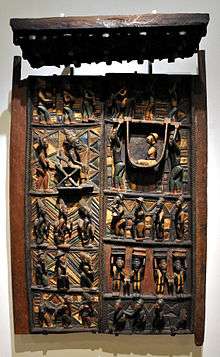Olowe of Ise

Olowe of Ise (born circa 1873, died circa 1938)[1][2] is considered by Western art historians and collectors to be one of the most important 20th century artists of the Yoruba people of what is today Nigeria, Africa.[3][4][5] He was a wood sculptor and master innovator in the African style of design known as oju-ona.
Olowe was born in Efon-Alaiye, a town known as a major cultural centre in Yorubaland, but he lived most of his life in the city of Ise. He was initially employed as a messenger at the court of King Arinjale of Ise. It is a matter of dispute whether his artistic career began as an apprenticeship or arose purely from his own natural talent. His fame as a sculptor appears to have begun at Ise under the patronage of Arinjale before spreading throughout eastern Yorubaland. Olowe was summoned to Ilesa, Ikere, Akure, Idanre, Ogbagi and other towns located within a 60-mile radius (96.75 kilometers) to create elaborate household (such as doors and veranda posts), personal and ritual objects for wealthy families.
Olowe's celebrated status as an artist was recorded by his contemporaries in Yoruba oral praise poetry known as oriki. For instance, this example sung by one of his wives and recorded in 1988.
International Fame
In 1924, Olowe's art was exhibited overseas for the first time when a door and lintel ensemble from the royal palace at Ikere was selected for the Nigerian Pavilion at the British Empire Exhibition at Wembley, London. This work of art was subsequently acquired by the British Museum.
References
- ↑ Christa Clarke; Rebecca Arkenberg (2006). The Art of Africa: A Resource for Educators. 1. Metropolitan Museum of Art (New York, N.Y.). ISBN 978-158-8391-902.
- ↑ Fred S. Kleiner (2015). Gardner's Art through the Ages: Backpack Edition, Book F: Non-Western Art Since 1300. Cengage Learning. ISBN 978-1-305-5449-49.
- ↑ http://www.nmafa.si.edu/exhibits/olowe/anon/anon2.htm National Museum of African Art, Smithsonian Institution exhibition of Olowe's art
- ↑ Art in World History, Mary Hollingsworth, 2003, Giunti, ISBN 88-09-03474-0
- ↑ Plundering Africa's Past, Roderick J. McIntosh & Peter Ridgeway Schmidt, 1996, Indiana University Press, ISBN 0-253-21054-2
External links and references
| Wikimedia Commons has media related to Olowe. |
Note that Olowe's sculptures were originally painted, but the paint has typically since worn down.
- Exhibition at the Smithsonian National Museum of African Art
- Assorted sculptures
- Veranda post Female Caryatid and Equestrian Figure before 1938
- Veranda post Caryatid, 20th century
- Veranda post 1910-1914
- Veranda post Enthroned King and Senior Wife 1910-1914